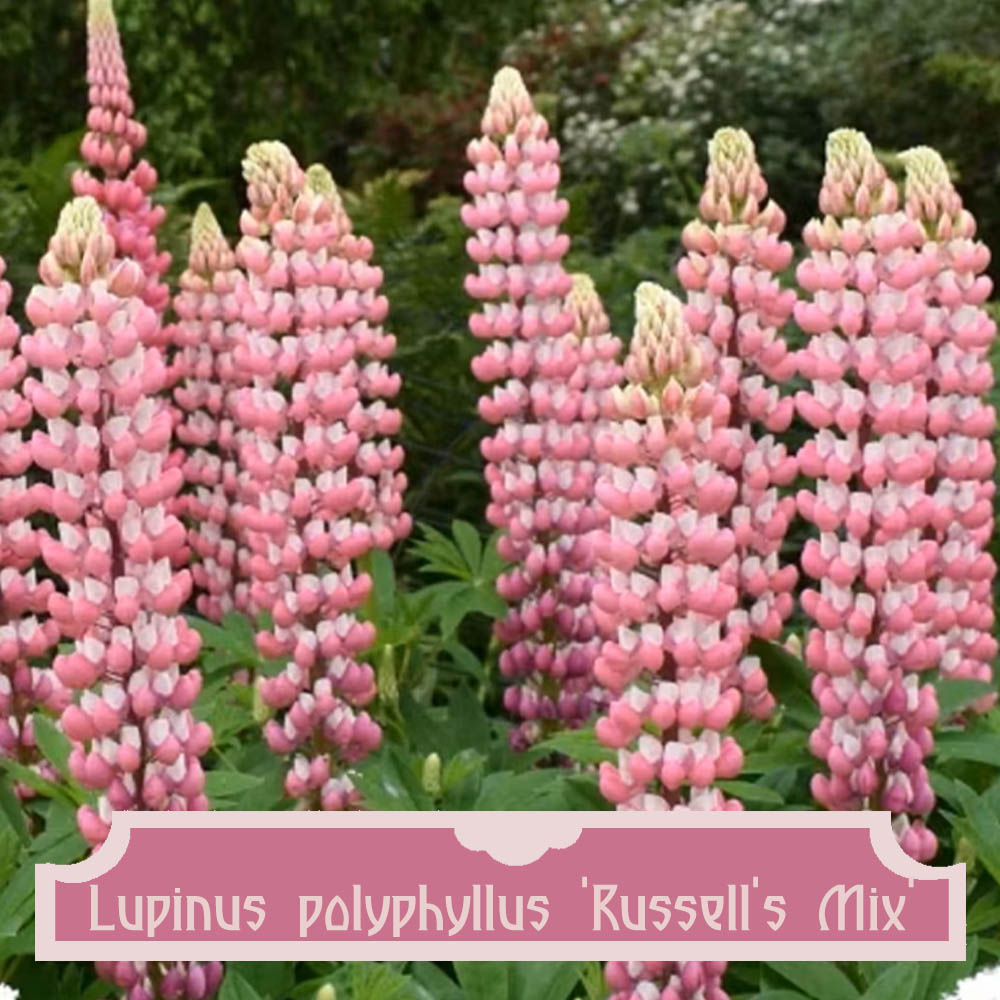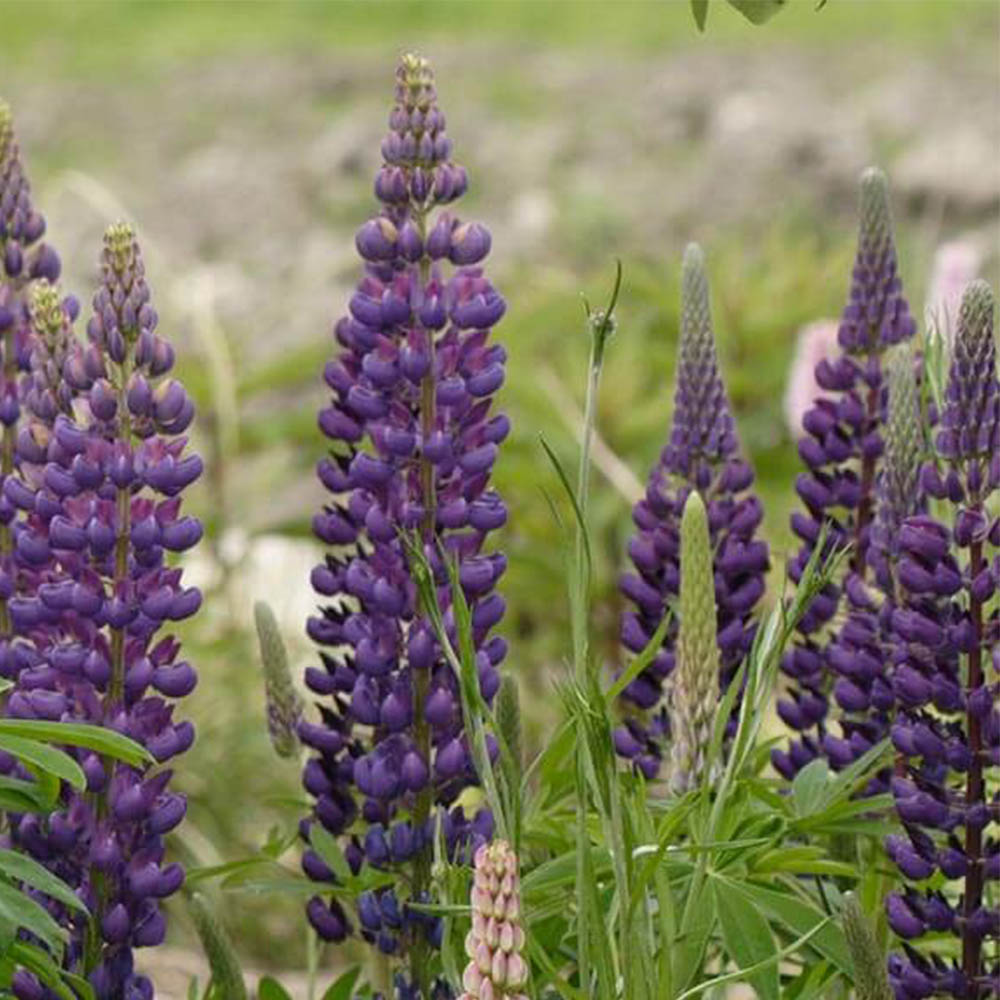-
 4,90 € × 1×€4.9
4,90 € × 1×€4.9
Customer matched zone "Locations not covered by your other zones"
“Lupin Russell Hybrids Mix” has been added to your cart. View cart
Lupin Russell Hybrids Mix
Extraordinary colors range of flowers on tall spires
Rated 0 out of 5
0 customer reviews4,90 €
Only 30 item(s) left in stock!
Tags: perennial, soleil, vivace
SKU: pda561
Category: Bees and Butterflies, Bouquet, Evergreen, Frost Hardy, Make it Pop, Rich and Humid, The Stunners

Lupin Russell Hybrids Mix
4,90 €
Only 30 item(s) left in stock!
Lupin Russell Hybrids Mix – technically Lupinus polyphyllus Russell Hybrid is a wonderful variety of lupines, forming stately flower spikes in an extraordinary range of colors above a rosette of palmate leaves.
The flowers are tall upright raceme of pea-like flowers – ranging in color from blues, pinks, reds, purples, whites, and bicolors.
The leaves are palmate, forming a basal roseette from which the flowers tower.
These lupins are bee magnets, attracting pollinators with their tall, nectar-rich flower spikes.
They can reach up to 1.2 meters (4 ft) in height, forming dramatic backdrops in garden borders.
While they are perennial, they often self-seed, creating naturalized patches over the years.
Note bene: the seedlings often do not breed true to the parent so the next generation of lupines in your garden will be yet another exciting round of colors!
👨🌾GARDENING TIPS👨🌾: Lupin Russell Hybrids Mix
Drought: Not highly drought tolerant. They prefer moderately moist, well-drained soil and may decline in prolonged dry spells, especially when young
. Established plants can survive short dry periods if soil retains some moisture, but consistent watering during hot summer months is recommended for best flowering and vigor.
Soil: Light to medium, well-drained, moderately fertile; avoid heavy clay or soggy soils
Sun exposure: Full sun is ideal; tolerates light shade but flowering may be reduced
Maintenance: Deadhead flower spikes to prolong bloom; cut back foliage after flowering to encourage healthy regrowth
Companion plants: Works well with delphiniums, campanulas, houttuynia
- Dramatic color accents in spring/early summer
Learn more about gardening with Lupines:
- ENG: Russell Lupines Growing Guide
- ENG: Lupine Basics
- ENG: Wonderful photos of a Toronto garden full of Lupines in full bloom : HERE
- FR: Le lupin au jardin bio
The Tales & The Botany: Lupin Russell Hybrids Mix
Russell spent decades selectively breeding for taller spikes, larger blooms, and an extraordinary range of colors—reds, blues, pinks, yellows, and bicolors.
So, Russell’s Mix lupins are named after George Russell himself, who reportedly spent over 20 years perfecting these hybrids, making them one of the earliest examples of intentional ornamental plant breeding in Europe.
Lupinus polyphyllus Russell’s Mix, commonly called Russell Hybrids, is a perennial garden lupin developed by English horticulturist George Russell in the early 20th century.
You can read about the full story here: Russell Lupines: The Story Behind the Glory of Those Colorful Spires
It is a hybrid of Lupinus polyphyllus (the native North American species) with selective breeding for large flower spikes, bright colors, and long-lasting blooms.
Their popularity soared after they were first exhibited at the Royal Horticultural Society show in 1937, where they wowed gardeners and have remained a staple ever since.
Floral Morphology: Lupin Russell Hybrids Mix
Russell lupins have tall, upright racemes of pea-like flowers, typical of the Fabaceae family.
Each flower is zygomorphic (bilaterally symmetrical) with a banner, wings, and keel, and produces nectar to attract bees and other pollinators.
Flowers can be single-colored, bi-colored, or multicolored, depending on the cultivar, and open from the bottom to the top of the spike over several weeks in late spring to early summer.
Leaves are palmately compound, usually with 7–15 lance-shaped leaflets radiating from a central point, forming a low rosette from which the flower spikes emerge.
Reproductive Biology
Russell hybrids are hermaphroditic and largely cross-pollinated by bees, although self-pollination can occur.
They readily set seed, and while the hybrids may produce viable seeds, seedlings often do not breed true to the parent, so propagation is usually done by division or purchasing named cultivars.
Deadheading spent flower spikes encourages more flowering and keeps the plant tidy, although many gardeners allow some seeds to drop naturally to self-sow in favorable conditions. Mature plants are perennial, typically living 5–7 years, although vigor may decline after several seasons unless divided
Other Names:
Lupin
Tramousses
Origin:
United Kingdom (though originally Lupinus polyphyllus is a North American species)
| Weight | 0,5 kg |
|---|---|
| Flower Color | Cream, Lilac, 🔵 Blue, 🟠 Orange, 🟣 Purple |
| Flowering | July, August, September |
| Soil | Moist, Nutrient-Dense, Well-Draining |
| Exposure | Full Sun |
| Frost Tolerance | -25°C to -30°C |
| Size | 1.2m H x 0.6m W |
Reviews
0
Rated 0 out of 5
0 customer reviews5
0
4
0
3
0
2
0
1
0
Only logged in customers who have purchased this product may leave a review.
You may also like…
Billbergia nutans
A bromeliad featuring a three colored, striped flower
A bromeliad featuring a three colored, striped flower
Rated 0 out of 5
Campanula porscharskyana Lisduggan Variety
A lovely wild ground cover with star shaped lavender flowers
A lovely wild ground cover with star shaped lavender flowers
Rated 0 out of 5
Campanula persicifolia ‘Telham Beauty’
A stately porcelain colored beauty
A stately porcelain colored beauty
Rated 0 out of 5
Delphinium requienii
Lilac-metallic flowers on tall spires
Lilac-metallic flowers on tall spires
Rated 0 out of 5
Houttuynia cordata ‘Chameleon’
A fragrant and ornamental perennial with color-shifting foliage
A fragrant and ornamental perennial with color-shifting foliage
Rated 0 out of 5
Related Products
Cerastium tomentosum var. columnae
A grey-green spreading ground cover from the mountains.
A grey-green spreading ground cover from the mountains.
Rated 0 out of 5
Euphorbia myrsinites
Known for its draping form of silver-gray foliage and radiant blooms.
Known for its draping form of silver-gray foliage and radiant blooms.
Rated 0 out of 5
Jacobaea maritima
A wooly white perennial plant from the Mediterranean region.
A wooly white perennial plant from the Mediterranean region.
Rated 0 out of 5
Artemisia alba subsp camphorata
A highly fragrant, grey-green bush.
A highly fragrant, grey-green bush.
Rated 0 out of 5
Tanacetum densum subsp amani
A shrublet composed of soft, finely divided silvery gray-white leaves.
A shrublet composed of soft, finely divided silvery gray-white leaves.
Rated 0 out of 5
Tradescantia Blushing Bride
Gorgeous blushes of pink and white that appear in the coldest nights.
Gorgeous blushes of pink and white that appear in the coldest nights.
Rated 0 out of 5
Echinops ritro
Tall, electric blue globe thistles
Tall, electric blue globe thistles
Rated 0 out of 5
Erigeron kavinskianus
A daisy-like carpet of flowers
A daisy-like carpet of flowers
Rated 0 out of 5
Sedum album
A low, multi-color ground cover.
A low, multi-color ground cover.
Rated 0 out of 5
Echinacea purpurea
A perennial with purple flowers all summer long
A perennial with purple flowers all summer long
Rated 0 out of 5
Artemisia vulgaris Oriental Limelight
Striking green and yellow variegated foliage.
Striking green and yellow variegated foliage.
Rated 0 out of 5
Satureja montana
A sweet smelling culinary herb from Europe
A sweet smelling culinary herb from Europe
Rated 0 out of 5
Mentha x piperita ‘Chartreuse’
A spicy mint, known for its use in the production of liqueurs and herbal teas.
A spicy mint, known for its use in the production of liqueurs and herbal teas.
Rated 0 out of 5
Hieracium maculatum Leopard
A native perennial with blue-green leaves and a tall yellow flower
A native perennial with blue-green leaves and a tall yellow flower
Rated 0 out of 5
Delosperma cooperi
A dwarf perennial known for its vermillion colored flowers
A dwarf perennial known for its vermillion colored flowers
Rated 0 out of 5
Vinca minor
Looping elegance and ability to form a low flowering ground cover
Looping elegance and ability to form a low flowering ground cover
Rated 0 out of 5
Glechoma hederacea
A sweet smelling ground cover, producing little blue flowers all summer long.
A sweet smelling ground cover, producing little blue flowers all summer long.
Rated 0 out of 5
Achillea ptarmica Boule de Neige
White pompom flowers to attract bees to your garden all summer long.
White pompom flowers to attract bees to your garden all summer long.
Rated 0 out of 5
recent view product
Cerastium tomentosum var. columnae
A grey-green spreading ground cover from the mountains.
A grey-green spreading ground cover from the mountains.
Rated 0 out of 5
Heuchera ‘Prince’
Wonderfully ruffled dark purple/black foliage
Wonderfully ruffled dark purple/black foliage
Rated 0 out of 5
Echinops ritro
Tall, electric blue globe thistles
Tall, electric blue globe thistles
Rated 0 out of 5
Achillea sibirica Love Parade
A unique variety with large pink flowers and shiny foliage
A unique variety with large pink flowers and shiny foliage
Rated 0 out of 5
Carex hachijoensis ‘Evergold’
An evergreen perennial grass with striped yellow-gold foliage.
An evergreen perennial grass with striped yellow-gold foliage.
Rated 0 out of 5




















































There are no reviews yet.